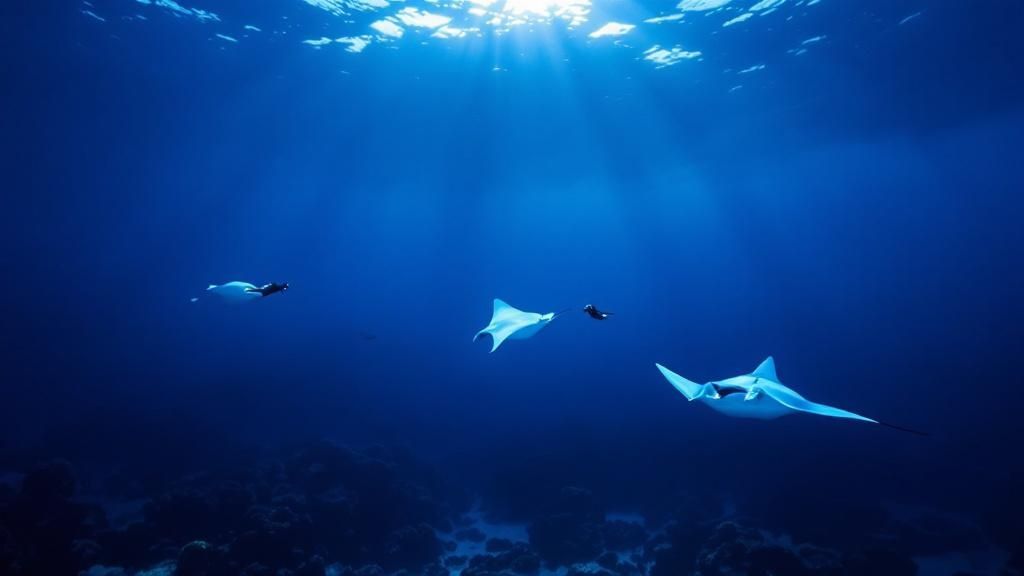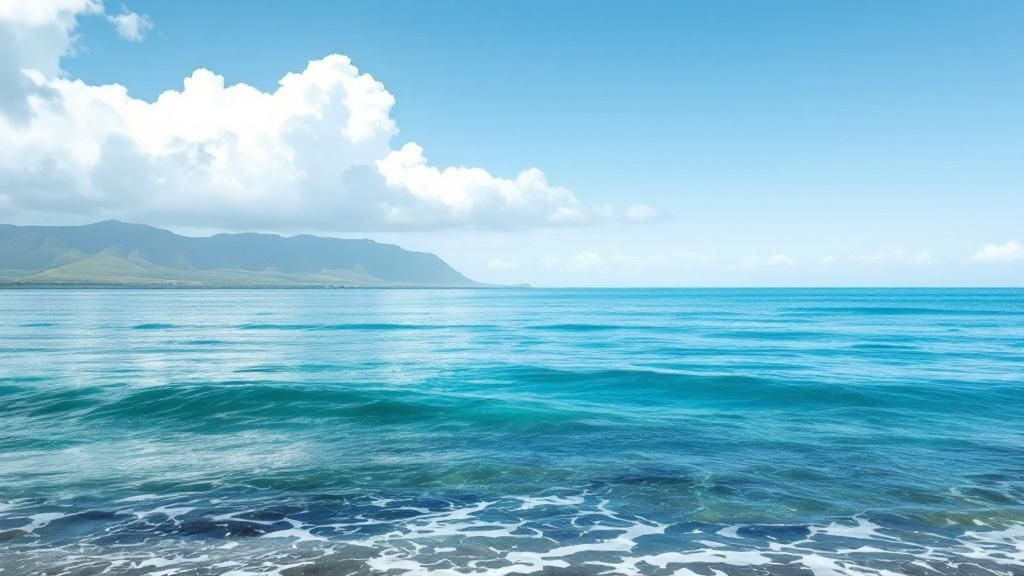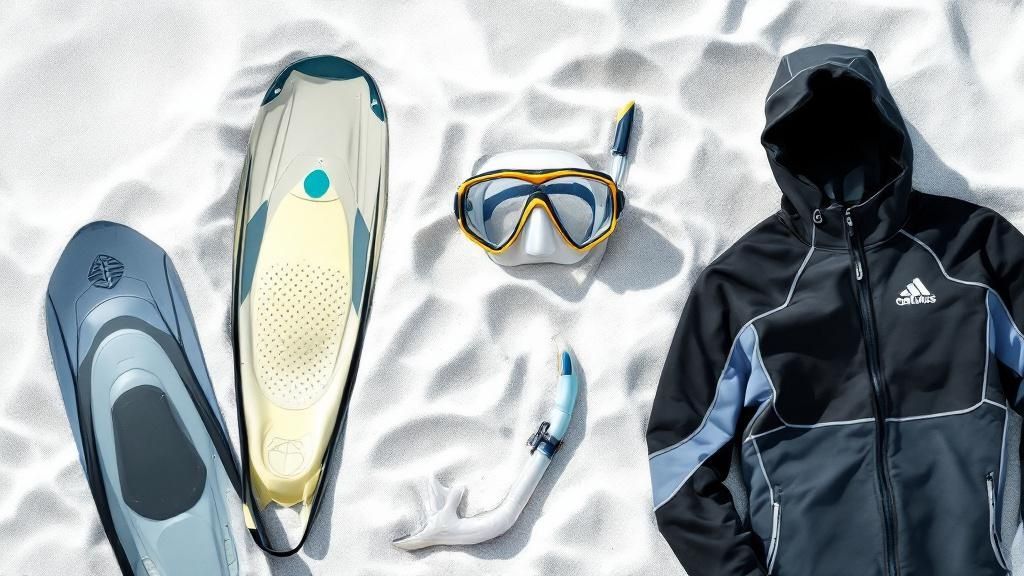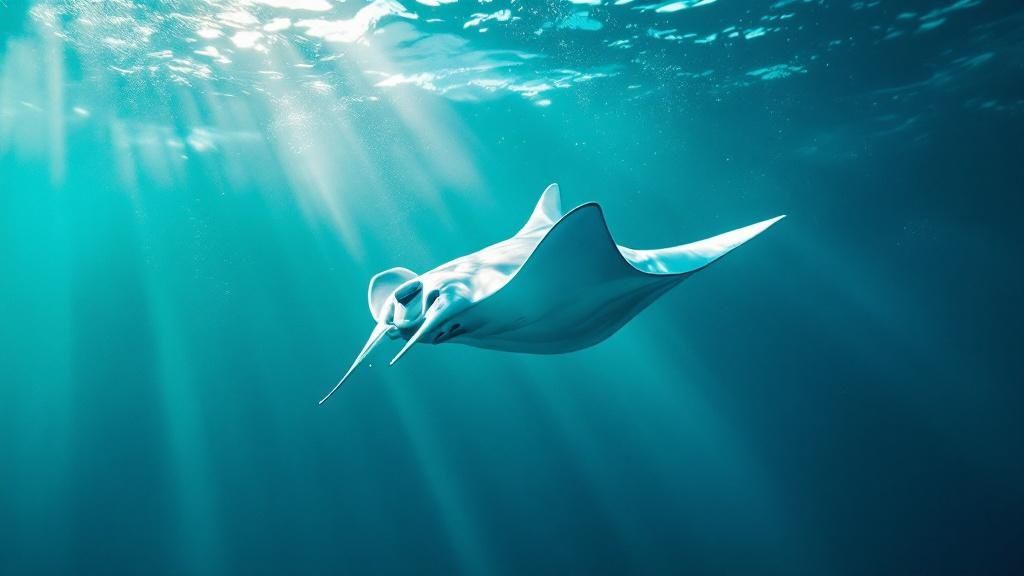Manta Ray Snorkel Kona: Top Guide for Your Adventure
- Byron
- Jun 19
- 12 min read
Why Kona Creates Perfect Manta Ray Encounters
Imagine a five-star restaurant that never closes, serving a favorite meal to loyal customers every single night. For the giant reef manta rays of Hawaii, the Kona coast is exactly that. This special stretch of the Big Island isn't just a lucky spot; it’s a perfectly arranged ecosystem that creates one of the most dependable manta ray experiences in the world. The magic starts with the island's volcanic history. The underwater lava rock formations give the mantas shelter and also create a unique landscape that channels nutrients and plankton.
This steady, concentrated food supply is the main reason mantas show up here every night. Think of it as a natural "dinner bell" ringing across the ocean. The warm, clear waters, which stay around a comfortable 75-80°F (24-27°C), create an ideal environment for both the rays and for snorkelers. This amazing combination of factors leads to a very high chance of seeing these incredible animals.
The Science of the Manta Buffet
The entire spectacle centers on plankton, the tiny organisms that are the foundation of the ocean's food chain. The powerful lights that tour boats shine into the water at night act like magnets for these microscopic creatures.
Plankton are naturally drawn toward light, a behavior known as phototaxis.
As clouds of plankton gather in the light beams, they form a thick, nutritious soup.
This predictable feast attracts the manta rays, who glide through the illuminated water, filtering thousands of gallons to get their fill.
This process turns the dark ocean into a glowing underwater ballroom, giving you a front-row seat to the graceful dance of feeding mantas. For more information on planning your trip around these natural cycles, take a look at our guide on the [best time to see manta rays in Kona](https://www.mantaraynightsnorkelhawaii.com/post/best-time-to-see-manta-rays-in-kona-your-ultimate-guide).
This chart from a local tour operator shows just how consistent manta ray sightings are.

The data makes it clear why Kona, Hawaii, is known worldwide as a top destination for this activity, with an impressive sighting success rate of 80-90% all year long. This high probability is directly tied to the unique environment where volcanic geology creates nutrient-rich waters, which in turn attract the huge swarms of plankton that manta rays feed on. You can learn more about [Kona's renowned manta ray snorkel success rates on konasnorkeltrips.com](https://konasnorkeltrips.com/blog/manta-ray-kona-snorkel/).
Your Real Odds of Swimming With Giants

When you book a manta ray snorkel in Kona, you're buying a ticket to a potentially unforgettable experience. But what are the actual chances of seeing these gentle giants? Unlike many wildlife encounters that hinge on seasonal migrations and pure luck, the Kona coast offers a remarkably dependable show. The odds are very much in your favor, especially once you know the factors at play.
The key to this consistency is Kona’s resident manta ray population. Researchers have identified a stable community of over 450 individuals. Each ray has a unique spot pattern on its belly, which acts like a human fingerprint, allowing them to be recognized. This large, non-migratory group means the mantas are present year-round, reliably visiting their favorite feeding spots. As a result, the success rate for night tours is an incredible 85-90%. You can see up-to-date information by checking a [local Manta Report](https://jacksdivinglocker.com/manta-report).
Factors That Influence Your Encounter
While seeing mantas is highly likely, certain conditions can elevate a good night into an amazing one. Experienced guides are skilled at reading the ocean's signs to forecast how active the mantas will be.
Moon Phases: The darker the night, the better the encounter. A new moon provides less background light, which makes the tour boats' bright underwater lights a more powerful beacon for plankton. This creates a concentrated "manta buffet," often leading to more rays and more energetic feeding.
Weather Patterns: Calm seas are always preferred. Mantas will still feed when the water is choppy, but calm conditions create a much more comfortable and safe experience for everyone. The winter months (November to March) can bring larger ocean swells, which might cause some tours to be cancelled for safety.
Plankton Cycles: The amount of available plankton isn't always the same. Seasonal blooms, which are often connected to small changes in water temperature and currents, can produce nights where dozens of mantas show up for a massive feeding event.
To give you a better idea of what to expect throughout the year, the table below breaks down the typical success rates and conditions.
Season | Success Rate | Average Rays per Tour | Best Conditions | Visibility |
|---|---|---|---|---|
Spring (Apr-Jun) | 90% | 5-10 | Calm seas, warmer water | Excellent (50-100 ft) |
Summer (Jul-Oct) | 90-95% | 8-15 | Very calm, peak plankton | Very good (40-80 ft) |
Fall (Oct-Nov) | 85-90% | 6-12 | Transitioning weather | Good (40-70 ft) |
Winter (Dec-Mar) | 85% | 4-8 | Can have larger swells | Good but variable (30-60 ft) |
This data shows that while summer often has the calmest weather and highest ray counts, your chances of a successful sighting are excellent no matter when you visit.
Manta Identification: Getting to Know the Locals
The ability to identify individual rays has completely changed our understanding of their behavior. It’s like being able to recognize specific people in your neighborhood. Scientists and tour guides can now track manta movements, health, and even social circles over many years.
During your tour, your guide might point out famous local rays by name, like "Big Bertha" or "Lefty," adding a personal connection to your underwater adventure. This long-term research proves that the Kona coast isn't just a random feeding spot; it's a vital, long-term home for these amazing animals, making your chances of a magical encounter consistently high.
Decoding Kona's Premier Manta Sites
Not every manta ray encounter is the same, and the location of your manta ray snorkel in Kona will significantly influence your experience. Think of it like picking a restaurant for dinner; some offer a quiet, intimate setting, while others provide a lively, bustling feast. Kona features a few world-class "restaurants" for mantas, and tour operators are skilled at reading the ocean conditions each night to pick the best spot.
The magic behind these sites is a simple but effective strategy: create a reliable food source, and the mantas will show up. Operators use powerful lights that attract plankton, essentially setting up a concentrated, all-you-can-eat buffet in the dark water. The seafloor geography is also important. Many sites have natural, amphitheater-like sandy bottoms, which allows everyone to settle in and watch the show without harming the delicate coral reef.
The Two Main Manta Hotspots
Most tours will guide you to one of two primary locations, often called "Manta Village" and "Manta Heaven." Each spot offers a slightly different atmosphere.
Manta Village (Kīneno): Situated south of Kailua-Kona near Keauhou Bay, this is the original and most famous manta site. It is renowned for its consistency, boasting a sighting success rate that often tops 95%. The underwater landscape forms a natural bowl, making it an extremely reliable feeding area, although it sometimes attracts fewer rays than its northern counterpart.
Manta Heaven (Garden Eel Cove): Found north of Kona, closer to the airport, this location can host a larger gathering of mantas. While its consistency is slightly lower than Manta Village's, it's not unusual for snorkelers here to witness a dozen or more rays gracefully gliding and feeding in a mesmerizing ballet.
This illustration shows the giant oceanic manta ray, a close relative of the reef mantas seen in Kona. The image gives you a sense of their impressive size and unique form, including the cephalic lobes they use to guide plankton into their mouths—a behavior you'll see up close.
Why Location Matters for Your Snorkel
The final decision between sites often comes down to the ocean swells and currents on any given night. Manta Village is more sheltered from the open ocean, making it the preferred choice when conditions are a bit rough. Manta Heaven is more exposed but can reward visitors with a truly staggering number of rays on calm evenings.
Both locations are protected within Marine Life Conservation Districts. This designation is crucial for preserving these essential habitats and ensuring the local manta ray population can thrive for generations to come. Your guide will ultimately make the call, selecting the "best table in the house" for that evening's underwater performance.
Mastering The Art of Night Snorkeling

There’s a unique feeling that comes with entering the dark ocean at night, where your only view is the glow from underwater lights. While a night snorkel might sound intimidating, the tours are structured to be safe and memorable, even if you've never snorkeled before. The experience starts on the boat with a detailed safety briefing. Guides will walk you through the gear, explain what to expect, and share interesting facts about the manta rays you're about to meet.
Once you slip into the water, you'll hold onto a specially designed flotation device, often resembling a raft or surfboard. These devices have powerful lights that beam down into the water, creating a stable and secure platform for you to float on. This means you can relax without having to swim. The light acts as a beacon for plankton, drawing in these tiny organisms to form a glowing buffet for the mantas. Think of it as building a bright, underwater "campfire" that attracts the stars of the show.
Witnessing the Underwater Ballet
As the plankton cloud grows, the main performance begins. A manta ray will emerge from the darkness, gliding gracefully into the illuminated area. You'll get a front-row seat to their feeding behavior, which looks like a carefully choreographed underwater ballet. The rays perform elegant barrel rolls and loops, their huge mouths wide open to filter the plankton from the water. They soar just inches below you, their massive wingspans creating a truly amazing sight.
Following the rules is crucial for a safe encounter for both you and the mantas. Here are the main guidelines for a responsible manta ray snorkel in Kona:
Be Passive: Your role is simply to watch. Avoid splashing or making sudden movements. You are a quiet guest in their natural dining space.
No Touching: Manta rays are covered in a protective mucous layer that shields them from infection. Touching them can remove this coating, leaving them vulnerable to diseases.
Stay at the Surface: Hold onto your flotation board and keep your body horizontal. This prevents you from accidentally kicking a manta and gives them plenty of room to swim freely beneath you.
The guides strictly enforce these rules to protect the local manta ray population, which has been part of long-term studies. To learn more about what makes this trip so special, read our article detailing this unforgettable night experience. By following these simple practices, we can help ensure the Kona manta encounters continue to be a sustainable and magical activity for everyone.
Choosing the Right Kona Manta Ray Tour Operator
With so many companies offering a manta ray snorkel in Kona, picking the right one can feel a bit daunting. Think of it like choosing a guide for an important expedition; the right one ensures your safety, makes the experience memorable, and respects the natural world you've come to see. The best operators aren't just running a boat trip—they see themselves as guardians of this incredible marine encounter.
A key factor that sets great companies apart is their commitment to sustainable tourism. They operate as partners with the ocean, not just as businesses using its resources. These operators follow strict guidelines that put the manta rays' well-being first, helping to ensure this amazing activity is around for years to come.
How to Evaluate Your Options
When you start comparing tour operators, it's important to look beyond just the price. The quality of your adventure is directly linked to the operator's standards. A fantastic tour is built on a solid foundation of safety, education, and deep respect for marine life. Before you book, it's wise to check their websites or ask a few key questions.
Guide Certification: Are the guides lifeguard-certified and knowledgeable about local waters? An experienced guide can interpret ocean conditions and share fascinating details about manta ray behavior.
Group Size: Do they keep their tour groups small? A smaller group usually leads to a more personal and less crowded experience, which means you get a much better view of the mantas.
Boat Safety: What are their safety procedures and equipment like? Look for well-maintained boats and clear safety briefings—these are essential.
Conservation Commitment: Do they actively support or participate in manta ray conservation? This shows a genuine dedication to the ecosystem you're visiting. You can explore [top-rated tours and see what they offer in our detailed guide](https://www.mantaraynightsnorkelhawaii.com/post/manta-ray-snorkel-kona-top-tours-experience-tips).
To help you compare, here's a look at some of the most respected tour companies in Kona and what makes them stand out.
Operator | Group Size | Tour Duration | Included Equipment | Conservation Focus | Price Range |
|---|---|---|---|---|---|
Sea Paradise | Small to Medium | ~1.5 - 2 hours | Wetsuits, snorkel gear, flotation devices | Manta Ray Green List certified, educational briefings | $120 - $150 |
Manta Ray Dives of Hawaii | Small | ~2 - 2.5 hours | All gear included, plus snacks and drinks | Strong educational component, strict viewing protocols | $130 - $160 |
Kona Ocean Adventures | Very Small (often 6-12 guests) | ~1.5 hours | Wetsuits, high-quality snorkel gear | Focus on intimate, respectful encounters | $140 - $170 |
Sunlight on Water | Small | ~2 hours | Wetsuits, snorkel gear, noodles | Ocean conservation advocates, family-owned | $135 - $165 |
This table shows that while prices are similar, the main differences lie in group size and the specific focus of the tour. Smaller operators might offer a more personal touch, while others are known for their deep educational programs.
Red Flags to Watch For
Just as there are signs of a quality tour, there are also warning signs that might point to a subpar experience. Be careful with operators who seem focused on quantity over quality. This often shows up as very large tour groups, which can make the encounter feel chaotic and take away from the magic.
Another red flag is a lack of clear information about their sustainable practices. Good operators are proud of their conservation efforts and usually feature them prominently. If a company can't explain how they protect the mantas—for instance, by enforcing a strict "no-touching" policy—it might mean their priority is profit, not preservation. Choosing a responsible operator ensures your adventure is not only breathtaking but also helps protect these gentle giants for the future.
Preparing for Your Underwater Adventure
Smart preparation can turn a good manta ray snorkel in Kona into a truly unforgettable experience. While the tour companies supply the necessary gear, taking a few steps to ensure your own comfort and confidence will let you soak in every moment. It all starts with knowing what to wear and what to pack.
Gearing Up for Comfort
Most tours will provide a wetsuit, and you should definitely use it. Even though Hawaiian waters are a pleasant 75-80°F (24-27°C), you'll be floating at the surface after the sun goes down, and you can get cold surprisingly fast. A standard 3mm wetsuit is usually perfect. Besides the gear they give you, think about bringing these personal items:
A warm jacket or hoodie: The boat ride back can feel quite chilly after being in the water. Having something dry and cozy to pull on is a huge plus.
A reusable water bottle: It’s important to stay hydrated, and bringing your own bottle is a great way to be kind to the environment.
Reef-safe sunscreen: If you're on a sunset tour, be sure to apply sunscreen well in advance. Hawaiian law requires mineral-based sunscreens (look for zinc oxide or titanium dioxide) to help protect the fragile coral reefs.
Mastering Your Mindset and Skills
Having the right physical gear is only part of the equation; being mentally prepared is just as crucial, especially if you're new to snorkeling or a little nervous about being in the ocean at night. Feeling at ease in the water is the key to enjoying the show.
If you're a snorkeling beginner, try to practice in a calm bay during the day. Get used to the rhythm of breathing through a snorkel and learn how to clear water from your mask. Even simple breathing exercises, like taking slow, deep breaths, can work wonders to keep you calm and centered as you float above the feeding mantas.
If you know you're prone to seasickness, it's a good idea to take precautions before you get on the boat. Over-the-counter medications or acupressure wristbands can make a world of difference. This ensures your attention stays on the amazing underwater ballet rather than on a churning stomach. By taking these simple steps, you set yourself up for a comfortable and incredible adventure with Kona’s gentle giants.
Making Your Manta Encounter Unforgettable

As your trip gets closer, a few key tips can help turn your manta ray snorkel in Kona from a simple tour into a memory you'll cherish forever. It’s not just about seeing these magnificent creatures; it’s about fully immersing yourself in the moment. Whether you're a bit nervous or a seasoned snorkeler, the feeling of awe while floating above the mantas is universal.
Photography and Positioning
Many people want to capture the perfect photo, but the trick is to be patient. Instead of trying to chase the perfect shot, let the mantas come to you. A great technique is to brace your camera against your flotation board to keep it steady. You can also use the powerful lights from your tour operator to your advantage.
Try to find a spot on the outer edge of the group's light board. This position often provides a clearer, less crowded view as the mantas glide into the illuminated area. The most important thing is to stay still and predictable, allowing you to become part of the underwater scenery rather than a disruption.
Contributing to Conservation Post-Snorkel
Your connection with the manta rays doesn't have to stop once you're back on the boat. Each manta ray has a unique pattern of spots on its belly, much like a human fingerprint. Many of the rays in Kona have already been identified and given names by researchers.
After your tour, you can become a citizen scientist by trying to identify the specific rays you saw. This turns your snorkeling trip into an active role in research and conservation.
Here are a few ways you can help:
Identify Your Ray: Use the photos you took to compare the spot patterns with online manta ray databases.
Follow Research: Support the organizations dedicated to protecting Kona's manta ray population.
Share Responsibly: When you post your photos online, make sure to mention the strict "no-touching" rule to promote respectful wildlife tourism.
By turning your memories into action, you play a part in ensuring these incredible animals can be enjoyed for generations to come. This experience often creates a deeper bond with the ocean and inspires a long-term commitment to protecting it.
Ready to create your own unforgettable memories? At [Manta Ray Night Snorkel Hawaii](https://www.mantaraynightsnorkelhawaii.com), we specialize in small-group tours that bring you face-to-face with these gentle giants in a safe and respectful way.
Comments